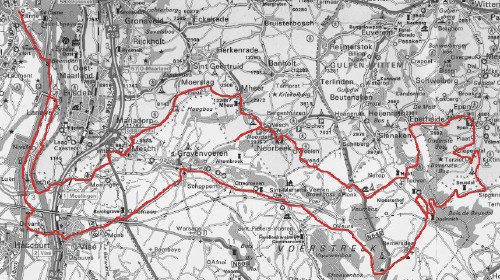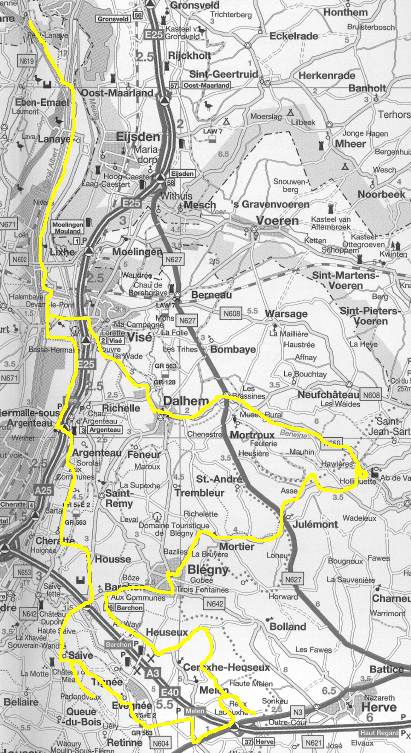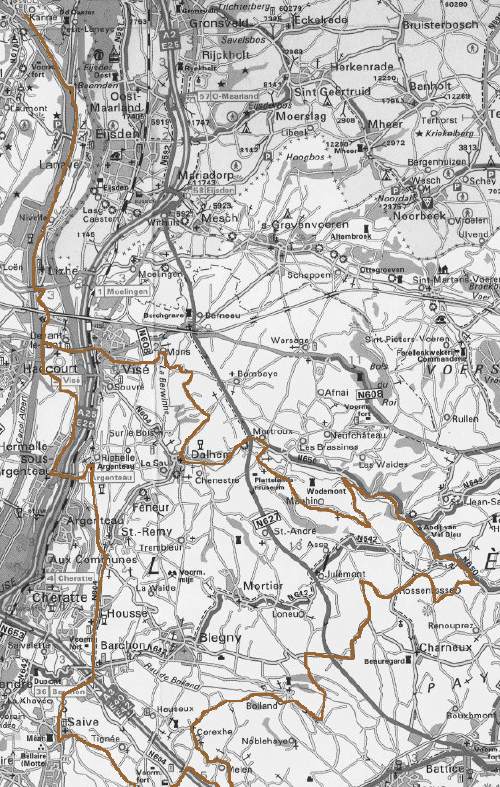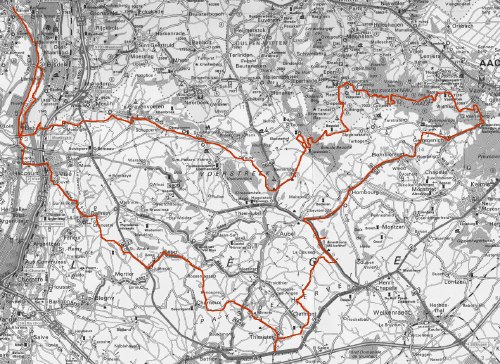14 graden, en een mooi zonnetje, de zuidenwind is afgenomen & eigenlijk is het ideaal fietsweer. Zuid-Limburg wordt bevolkt door wandelaars en er zijn behoorlijk wat groepjes wielrenners op weg. 11.15 – 14.30. Al verlang ik inmiddels terug naar Amsterdam, en zelfs een beetje naar fietsen door de polder, ik zal het landschap hier gaan missen.
Kanne – Lanaye – Moelingen – Mesch – Libeek – Mheer – (stukje Altembroek) – Noorbeek – Vroelen – Ulvend – De Plank – Teuven – Gieveld – Eperheide – Terziet – Sippenaeken – Opsinnich – Remersdael – Veurs – St. Martensvoeren – Gravensvoeren – Berneau – Vise – kanaal – Kanne

De thermometer op het kruispunt in Blegny zei: 25-11 17 graden. 12-11 18 graden. Het was ridicuul warm. Het woei ook hard, heel hard, uit het zuiden, er recht tegenin langs het Albertkanaal kwam de snelheid soms niet boven de 18 per uur. Maar eenmaal in de luwte was het heerlijk fietsen. Achteraf merkwaardig dat ik niet veel verder ben gereden (wel, werk te doen). Hier en daar wat zitten dwalen en wel eens expres een klim gedaan waar een bord zei ‘doodlopend’.
Kanne – kanaal – Hermalle ss Argenteau – Sarolay – Housse – Saive – (onbekende klim v.v.) – Evegnee – Rue de Reux – fietspad – Melen – Barchon – Blegny – Mortier – Julemont – Val Dieu – Mortroux – Dalhem – Visee – kanaal – Kanne

Tetuzi Akiyama — my favorite guitar player of the moment — is playing with Jozef van Wissem at DNK/OT301 on monday. I’ve known this since months. I even scheduled my agenda around it, so I’d be able to go. And now I can’t….
This is a very simple and partial perception. When I started teaching HTML and webdesign, there were a lot of women and girls getting into that. That’s 10 years ago. When for the first time I did a guest lecture at an ICT-academy, some 3 years ago, the majority of students were boys, but at least there were some girls too. Next week I’l do a social software workshop at ICA in Arnhem and for the second time in a row all the students are boys. Not one single girl. Last week at the Mediamatic RFID-workshop all the participants were men/boys. Melanie Rieback was the only female & she was a speaker (and btw, by far the most hardcore technologist of all). Where are the girls? The problem is not that there aren’t any good role models… or no good female teachers, or developers around (in my immediate environment I can think of Joan Heemskerk of Jodi, Sher Doruff, Kristina Andersen, or fokky). (And Flickr was developed by Christina Fake). The thing is also that these workshops are not ‘about technology’ at all — and if they are about technology it’s really lo-tech. These workshops are much much more about social use — and I think it’s a very bad idea to let the whole field of developing and thinking up of new tools, to the boys only…
Ah well. Please tell me I’m wrong.
“An author who is writing specifically for a public is not really writing; it is the public that is writing, and for this reason the public can no longer be a reader; reading only appears to exist, actually it is nothing. This is why works created to be read are meaningless: no one reads them. This is why it is dangerous to write for other people, in order to evoke the speech of others and reveal them to themselves: the fact is that other people do not want to hear their own voices; they want to hear someone else’s voice, a voice that is real, profound, troubling like the truth.” p. 365
Maurice Blanchot, ‘Literature and the Right to Death’ in The Station Hill Blanchot Reader, Barrytown, Station Hill, 1999, p. 359-399.
Sometimes I can read Blanchot, and what he writes I find beautiful and deeply true. Sometimes I cannot read Blanchot, and what he writes is to me as words from an ideal, transcendental realm, unconnected to lived reality.
… and then there are books that are very difficult to finish. Books about which you wonder, while reading if it is worth while at all. Books that strike you as weak, superfluous, boring, books of which you hardly understand what it’s about or what ‘the fuss’ is about, but that nevertheless carry you forth, page after page. Mark Z. Danielewski Only Revolutions falls into that category. I am reading it, still, sometimes, like 50 pages at a stretch. The text seems to me limited — however ‘beautifully’ the book is made –, limited as a celebration of the United States as the union or the love between both the protagonists, always (all ways) on the run. (Well, this is what the book seems to be — a celebration of “America”, that is at the same point a critique of America — a venerable tradition in American literature). Yet the ending (of both their narratives) has a tone that is reminiscent of the last pages of FW — which is another way of saying they are very very beautiful. Then again the connection between the story and the events in world history (the chronicle in the margin) is not really there — which makes the chronicle like a trick only. And I was very disappointed to see that Danielewski decided to not imagine what will happen in the future…
So, what is this book by Danielewski… Is it an example of what literature can be now (and in the future), or is it a mistake and a failure… a good one, for sure, but still a mistake & failure. (Adding here that I think FW is not a mistake and failure, nor is Infinite Jest, but that for instance the later novels of Arno Schmidt may be seen as mistakes & failures).
I’d love to read a good essay on this….
More books are written than you can read. Until you are, say 40, you read fully expecting you’ll get a chance to re-read. But will you? So many books to read and time will run out, eventually. One cannot read everything and so you begin to make decisions, conscious decision as to what not to read. Some of these decision are hardly decisions — I do not read thrillers, I do not read Indonesian or Bulgarian novels. More interesting are decisions against certain writers that do pop up in your ‘cultural’ environment. Books & authors that you tried reading, but that, repeatedly, did not strike a chord in you… Nabokov. Dostojevski. Pamuk. I tried reading their novels and I never finished one. Came halfway De Gebroeders Karamazov but was so put off by the christian/religious theme in the book that I could not stomach reading the rest. And now also, Nathan Safran Foer. Last monday (at last) started reading his much-discussed Incredible Loud and Extremely Close (sh*t, do I remember the title correctly?), and after 50 pages lost interest, read a few bits from middle and end, looked at all the ‘nice’ experimental pages (well, not so experimental at all) and decided that the book was too sentimental for my taste. Sorry.
Question: I can stand Richard Powers’ bordering on sentimentality. Why not Foer’s?
Goed, je fiets wordt er vreselijk smerig van, maar misschien vind ik dit wel ideaal fietsweer: droog en een laagstaand zonnetje na regen, de bomen geel en bruin en bijna rood, graad of twaalf, weinig wind. Twee miezerbuitjes van niet langer dan een minuut. Prachtig novemberweer. Net voor Vise werd ik bijgehaald door een man of acht uit Fleron – de blauwgelen van Electrabel (?). Ik haakte aan bij wat hun zaterdagse wintertraining bleek te zijn (zij hadden er al aardig wat kilometer opzitten), en wonder boven wonder reden zij tot voorbij Evegnee exact de route die ik wilde doen. Maakte een praatje, tot ik doorging richting Bolland en zij naar huis. Knoopte in het vervolg nog hier en daar een extra lusje vanwege het fijne weer en kwam helemaal ontspannen thuis: dit is een echte zaterdag, een fijne zaterdag.
Kanne – kanaal – Hermalle ss Argenteau – Richelle – St. Remy – Housse – Saive – Tignee – Evegnee – Melen – Bolland – Charneux – Rossenfosse – Val Dieu – Mauhin – Mortroux – Dalhem – Bombaye – Mons – Vise – kanaal – Kanne

Vrijdag, ‘s ochtends weg voor een mooi rondje, 50 kilometer? Prachtig weer met een gouden zon – gewoon een nazomerzon – deed me besluiten om nog over Hombourg en dan via het Drielandenpunt te rijden. De bossen geel & bruin en soms bijna rood in de laagstaande zon. 13 graden, stevige zuidwestenwind. Zachte novemberdagen: perfect fietsweer. (Afgezien van de bladeren op straat die soms een bocht verraderlijk glad maken: in de afdaling naar Camerig moest ik remmen voor een langzaam rijdende tegemoetkomende motor die te ver links zat, gelukkig reed ik al langzaam, want ik slipte behoorlijk).
Kanne – kanaal – Vise – Dalhem – St. Andre – Julemont – Charneux – La Minerie – Thimister – Clermont – Birven – Hombourg – Plombieres – Gemmenich – Drielandenpunt – Vaals – Camerig – Kuttingen – Beusdal – Opsinnich – Remersdael – Veurs – St. Martenvoeren – Gravensvoeren – Moelingen – Lixhe – Lanaye – Kanne

I’ve put a pdf of my presentation at the RFID-workshop online, for download. In my talk I dealt with the development of blogging-software as an example of the co-development of software and uses/users, using both Latour and Andrew Liu’s ‘Discourse Network 2000’ as an inspiration. Showing how a genre is constituted both by needs of users/writers and by software that is developed in response to those needs. Well, this goes through stages — for instance at one point it is blogging software that actually defines the genre. Next stage — where we are now — is when blogposts can & are used and re-used in different contexts, aggregation/syndication, when one is blogging without ever looking at the back-end of the blogsoftware, or even ‘blogging’ automatically. (Et cetera — hope you catch my drift). I’m trying to formulate what this means for the concept of ‘publishing’.
This is also what I will be discussing next week in my lecture in Groningen (15.00, Radesingel 6, Frank Mohr Institute).
Anyway, the pdf is for download here: http://www.ariealt.net/mediamatic_rfid/.
The first half is the actual presentation I did, what follows is a recap, and it ends with a collection of reserve ‘sheets’ that cover issues that I expected Julian Bleecker to talk about (but that I wanted to have handy, in case someone would ask me about it).



